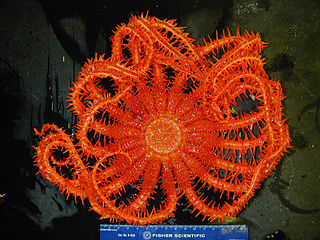
Asterias is a genus of the Asteriidae family of sea stars. It includes several of the best-known species of sea stars, including the (Atlantic) common starfish, Asterias rubens, and the northern Pacific seastar, Asterias amurensis. The genus contains a total of eight species in all. All species have five arms and are native to shallow oceanic areas of cold to temperate parts of the Holarctic. These starfish have planktonic larvae. Asterias amurensis is an invasive species in Australia and can in some years become a pest in the Japanese mariculture industry.

The Valvatida are an order of starfish in the class Asteroidea, which contains 695 species in 172 genera in 17 families.

Asterias amurensis, also known as the Northern Pacific seastar and Japanese common starfish, is a seastar found in shallow seas and estuaries, native to the coasts of northern China, Korea, far eastern Russia, Japan, Alaska, the Aleutian Islands and British Columbia in Canada. Two forms are recognised: the nominate and formarobusta from the Strait of Tartary. It mostly preys on large bivalve molluscs, and it is mostly preyed on by other species of starfish. Population booms in Japan can affect the harvest of mariculture operations and are costly to combat.

The Asterinidae are a large family of sea stars in the order Valvatida.

Coscinasterias is a genus of sea stars of the family Asteriidae.

Solaster paxillatus, the orange sun star, is a species of starfish found at varying depths in the northern Pacific Ocean. It is a natural predator of the starfish Asterias amurensis.

Goniasteridae constitute the largest family of sea stars, included in the order Valvatida. They are mostly deep-dwelling species, but the family also include several colorful shallow tropical species.

Asterina is a genus of asteroideans in the family Asterinidae.

Henricia is a large genus of slender-armed sea stars belonging to the family Echinasteridae. It contains about fifty species.

Leptasterias is a genus of starfish in the family Asteriidae. Members of this genus are characterised by having six arms although five-armed specimens sometimes occur. L. muelleri is the type species. The taxonomy of the genus is confusing and Leptasterias hexactis seems to be a species complex. Some species brood their eggs.

Solaster is a genus of sea stars in the family Solasteridae.

Evasterias troschelii is a species of starfish in the family Asteriidae. Its common names include the mottled star, false ochre sea star and Troschel's true star. It is found in Kamchatka and the north western coast of North America.

The Brisingidae are a family of starfish found only in the deep sea. They inhabit both the Atlantic and Pacific Oceans at abyssal depths, and also occur in the Southern Ocean and around Antarctica at slightly shallower depths.

Poraniidae is a family of starfishes in the order Valvatida.
Trophodiscus is a genus of starfish in the family Astropectinidae. There are only two species, both found in fairly deep waters in the Sea of Okhotsk. Trophodiscus almus is also found in the Sea of Japan and around the Japanese island of Hokkaido. These starfish are very unusual in that the young are brooded on the upper surface of the female.

Evoplosoma is a genus of deep-sea sea star in the family Goniasteridae.

Asterias rollestoni is a common starfish native to the seas of China and Japan, and not known from the far north or the American coasts of the eastern Pacific.
Asterias argonauta is a starfish native to the Pacific coasts of Far East Russia.
Asterias microdiscus is a starfish native to the Pacific coasts of Far East Russia.
Asterias versicolor is a species of starfish native to the southern coasts of Japan southwards to the South China Sea.















